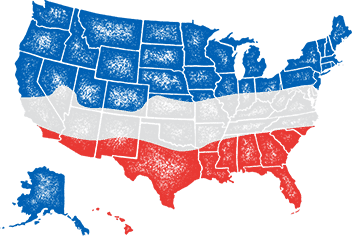Buckwheat is warm-season, broad-leafed annual, primarily used for weed suppression. Buckwheat is also popular among beekeepers because it produces an abundance of flowers, and a dark-flavored honey with a distinctive flavor. Buckwheat is also a great addition to any food plot for game birds, such as turkey, dove, ducks, and especially quail.
Product Detail
- Application or Use: Pollinators, Weed Suppression, Ground Cover, Cover Crop, Food Plot, Green Manure
- Germination Time: 5 – 7 days, under optimal conditions
- Growing Locations: Warm Season, Transition Zone & Cool Season
- Height: 2 – 4 feet
- Sunlight Requirements: 6+ hours, full sun for best results
- Advantages: Tolerant of moderate wet conditions and moderately acidic soils.
- When to Plant: Recommended planting time is early spring or summer when nighttime temperatures are consistently 55+ degrees and 2 months prior to first frost.
Product Information
- Non-GMO
- Can tolerate moderately acidic soils
- Typically planted in early spring or fall
- Great addition to cover crop mixes
- Will out-compete weeds if well-sown
Buckwheat, contrary to its name, is not related to wheat at all, and in fact is not even a grass. The species is actually more closely related to rhubarb, although we do not at all encourage using Hancock's particular variety of Buckwheat for home cooking.
Buckwheat grows best in soils with light to medium texture, good drainage and will tolerate moderately acidic soils. It is reportedly tolerant of poorly drained soils, but should be avoided on heavy or droughty soils. Buckwheat is planted in the northeastern United States and Canada in the summer, and in the southeastern United States in early spring or fall. Buckwheat can germinate and grow in temperatures as low as 45 degrees but optimal growth occurs at or above 55 degrees. Buckwheat is frost sensitive and does not survive even light frosts.
Buckwheat should be planted at least 60 days before the first expected frost date or before the hot and dry season. A well-sown buckwheat will out-compete weeds. Buckwheat is also seldom damaged by insects or diseases. For this reason, buckwheat has no registered pesticides or herbicides. Buckwheat can be included in cover crop mixes with cow peas, soybeans, sunn hemp, or other warm season annuals. Buckwheat will being to flower within 3 to 6 weeks after planting and flower continuously for several weeks. Buckwheat grown for beneficial bugs should be allowed to flower for at least 20 days.
*Product packaging may appear different than what is pictured.
**Buckwheat Seed is Non-GMO**

Buckwheat seed will thrive in any one of the three climate zones, when planted during the Spring or Summer. Seed at a rate of 70 lbs. per acre when broadcasting, or 50 lbs. per acre when drilling, and fertilize at a rate of 250 to 300 lbs. per acre with a suitable fertilizer. Cover seed at a depth of half-an-inch to one inch. Buckwheat performs best when soil is at a pH of 5.0 to 6.5. Be sure to do a soil test before planting and treat accordingly.
Buckwheat Seed will grow for 10 to 12 weeks, and will grow to a height of up to 30 to 50 inches.
Buckwheat produces a white flower, which makes it a reasonable addition to large flowerbeds, for both aesthetic and soil health purposes. The flowers are popular among bees and other beneficial bugs, providing an extra benefit for the local ecosystem when planted.
Buckwheat Seed
Buckwheat is warm-season, broad-leafed annual, primarily used for weed suppression. Buckwheat is also popular among beekeepers because it produces an abundance of flowers, and a dark-flavored honey with a distinctive flavor. Buckwheat is also a great addition to any food plot for game birds, such as turkey, dove, ducks, and especially quail.

Instructions
For more info on planting instructions and tips for the best results – check out our Warranty & Planting Information here!
Buckwheat seed will thrive in any one of the three climate zones, when planted during the Spring or Summer. Seed at a rate of 70 lbs. per acre when broadcasting, or 50 lbs. per acre when drilling, and fertilize at a...
Buckwheat Seed
193Buckwheat is warm-season, broad-leafed annual, primarily used for weed suppression. Buckwheat is also popular among beekeepers because it produces an abundance of flowers, and a dark-flavored honey with a distinctive flavor. Buckwheat is also a great addition to any food plot for game birds, such as turkey, dove, ducks, and especially quail.





















